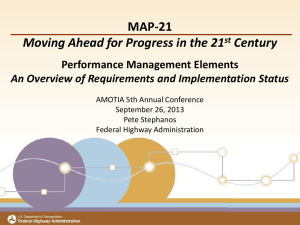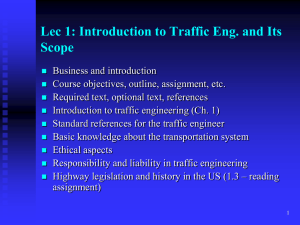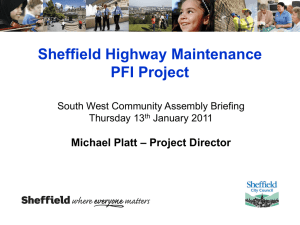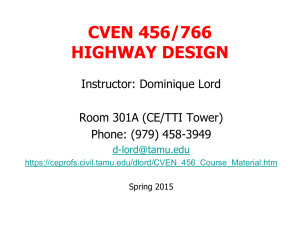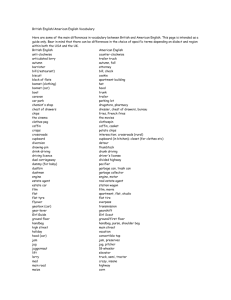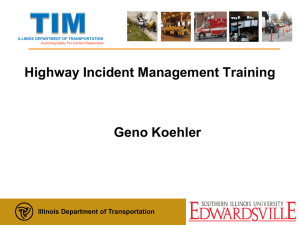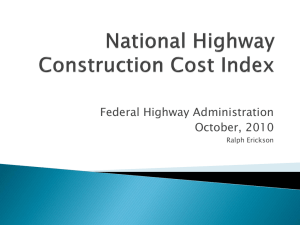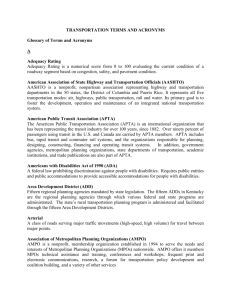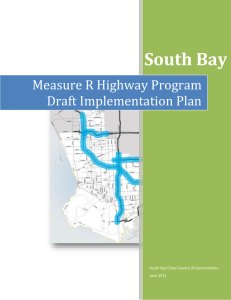Surface Transportation Program Project
advertisement
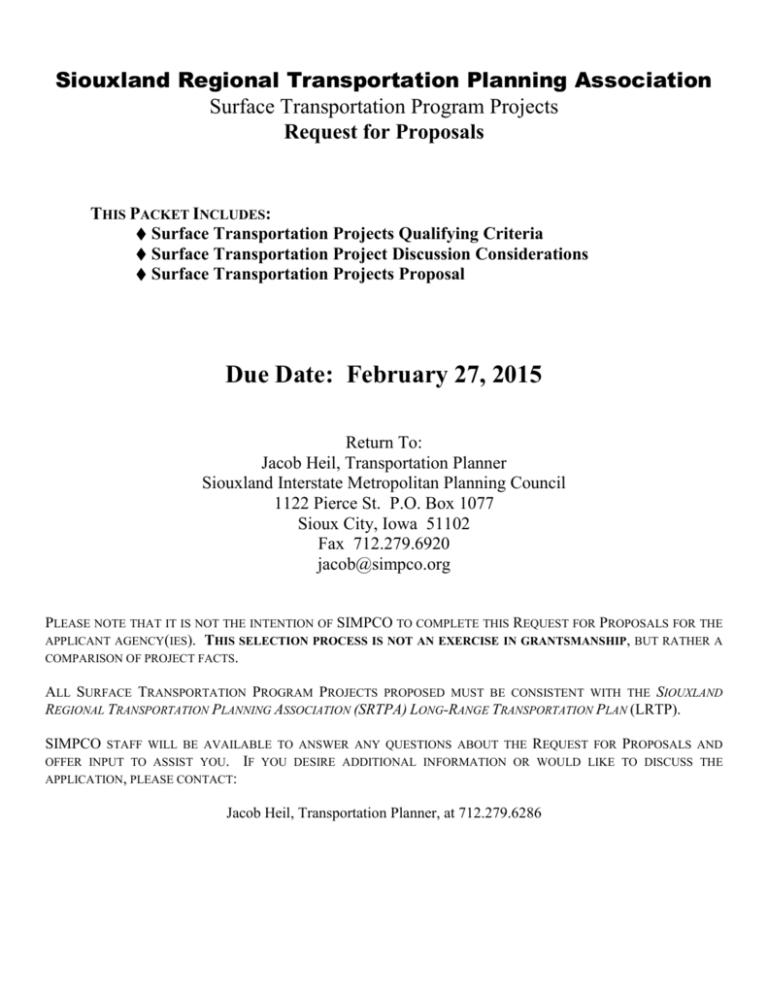
Siouxland Regional Transportation Planning Association Surface Transportation Program Projects Request for Proposals THIS PACKET INCLUDES: Surface Transportation Projects Qualifying Criteria Surface Transportation Project Discussion Considerations Surface Transportation Projects Proposal Due Date: February 27, 2015 Return To: Jacob Heil, Transportation Planner Siouxland Interstate Metropolitan Planning Council 1122 Pierce St. P.O. Box 1077 Sioux City, Iowa 51102 Fax 712.279.6920 jacob@simpco.org PLEASE NOTE THAT IT IS NOT THE INTENTION OF SIMPCO TO COMPLETE THIS REQUEST FOR PROPOSALS FOR THE APPLICANT AGENCY(IES). THIS SELECTION PROCESS IS NOT AN EXERCISE IN GRANTSMANSHIP, BUT RATHER A COMPARISON OF PROJECT FACTS. ALL SURFACE TRANSPORTATION PROGRAM PROJECTS PROPOSED MUST BE CONSISTENT WITH THE SIOUXLAND REGIONAL TRANSPORTATION PLANNING ASSOCIATION (SRTPA) LONG-RANGE TRANSPORTATION PLAN (LRTP). SIMPCO STAFF WILL BE AVAILABLE TO ANSWER ANY QUESTIONS ABOUT THE REQUEST FOR PROPOSALS AND OFFER INPUT TO ASSIST YOU. IF YOU DESIRE ADDITIONAL INFORMATION OR WOULD LIKE TO DISCUSS THE APPLICATION, PLEASE CONTACT: Jacob Heil, Transportation Planner, at 712.279.6286 QUALIFYING CRITERIA – SURFACE TRANSPORTATION PROJECTS 1. To be eligible as a Surface Transportation Program activity, any project or area served by the project must fit one or more of the following categories: - Construction, reconstruction, rehabilitation, resurfacing, restoration, preservation, or operational improvements for highways, including construction - Replacement, rehabilitation, preservation, protection and application of environmentally acceptable, minimally corrosive anti-icing and deicing compositions for bridges and tunnels on public roads of all functional classifications - Construction of a new bridge or tunnel at a new location on a Federal-aid highway. - Inspection and evaluation of bridges and tunnels and training of bridge and tunnel inspectors and inspection and evaluation of other highway assets. - Capital costs for transit projects including vehicles and facilities (publicly or privately owned) that are used to provide intercity passenger bus service. - Carpool projects, fringe and corridor parking facilities and programs, including electric vehicle and natural gas vehicle infrastructure - Bicycle transportation and pedestrian walkways - Highway and transit safety infrastructure improvements and programs - Highway and transit research and development and technology transfer programs - Capital and operating costs for traffic monitoring, management, and control facilities and programs, including advanced truck stop electrification systems - Surface transportation planning programs - Transportation alternatives - Transportation control measures in the Clean Air Act - Development and establishment of management systems. - Environmental mitigation efforts - Intersection projects that have safety and/or congestion problems - Infrastructure-based intelligent transportation systems capital improvements. - Environmental restoration and pollution abatement - Control of noxious weeds and aquatic noxious weeds and establishment of native species - Projects and strategies designed to support congestion pricing - Recreational trails projects - Construction of ferry boats and ferry terminal facilities - Development and implementation of a State asset management plan for the National Highway System - Construction and operational improvements for any minor collector ifo the minor collector and the project to be carried out are in the same corridor and in proximity to a National Highway System route; o the construction or improvements will enhance the level of service on the National Highway System route and improve regional traffic flow; and o the construction or improvements are more cost-effective, as determined by a benefit-cost analysis, than an improvement to the National Highway System route. - Workforce development, training, and education activities NOTE: This list is exclusive; a project must fit into one of the categories to be eligible for Surface Transportation Program funds. For a full list of eligible items and criteria, please refer to http://www.fhwa.dot.gov/map21/guidance/guidestp.cfm 2 2. Projects must have an assured local (non-federal funds) match of at least 20 percent of the estimated total cost of the proposed project. Moving Ahead for Progress in the 21st Century (MAP-21) requires a non-federal match of at least 20 percent of project costs. Assurance of this required local match by the proposer at the time of the application indicates a necessary level of support by the proposer to immediately proceed with the project development and implementation. 3. Projects must be submitted through/by counties or incorporated cities. All MAP-21 federal funds received by the State of Iowa will be received and disbursed by the Iowa Department of Transportation (Iowa DOT). With MAP-21, projects within smaller cities and towns may now be eligible for federal aid. Surface Transportation Program funds are available as a reimbursement program administered by the Federal Highway Administration (FHWA). Reimbursement will be received from federal highway funds for the federal portion (up to 80 percent of total expenditures) of those expenditures for the project. All applications of STP funds by cities of less than 5,000 population, shall be submitted to the respective County Board of Supervisors for review and approval. 4. Projects must be proposed on eligible roads. The STP provides flexible funding that may be used by States and localities for projects on any Federalaid highway, including the National Highway System (NHS), bridge projects on any public road, transit capital projects, and intracity and intercity bus terminals and facilities. Applicants should refer to the Federal Functional Classification map available at the county engineer’s office, the Siouxland Interstate Metropolitan Planning Council office, and the Iowa Department of Transportation Northwest Iowa Transportation Center in Sioux City to check eligibility. 3 DISCUSSION CONSIDERATIONS – SURFACE TRANSPORTATION PROJECTS Each of the following considerations is used during project selection. The considerations listed below are representative of the amount of weight given to certain aspects of the project during the application review. Each consideration is related to the questions within the application. 1. Is this project currently in the Long Range Transportation Plan 2. Projects with an assured local (non-federal funds) match in excess of 20 percent The demand for Surface Transportation Program funds far exceeds the amount made available to Iowa. Providing a modest incentive for proposers to exceed the minimum required local (non-federal funds) match (20 percent) will enable leveraging implementation of more projects in more locations throughout the state. 3. Projects with components which have already been funded and/or implemented from other funding sources, especially projects for which proposed surface transportation projects would complete a larger project, concept, or plan There may be a number of larger projects that are missing a key or final element. Funding these missing elements with Surface Transportation Program funds would provide additional benefits to funded projects. 4. Projects that have already gone through a statewide, regional, and/or local priority setting process In some cases, the proposed project has already been included in the list of priorities for the locality, region, or the state, but was not completed due to funding limitations. There appears to be a number of very good projects that have gone through one or more of these processes but remain unfunded or underfunded because of limitations on the availability of funding in these programs. 5. Projects which demonstrate a regional impact on economic development Does this project benefit more than one neighborhood, community, or county, or are recognized as being of regional or interregional significance? Does this project demonstrate the improvements or enhancement of the movement of freight and services? 6. Project Average Annual Daily Traffic and the projected Average Annual Daily Traffic 7. Project Federal Functional Classification 8. Does this project request funds for alternative modes of transportation and/or will use funds for planning purposes? 4 Proposal for Siouxland Regional Transportation Planning Association Surface Transportation Program Project CHECKLIST: The following items must be provided for all Surface Transportation projects. ☐ Surface Transportation Project Proposal ☐ Surface Transportation Project Location Map(s) ☐ Resolution from a Sponsoring Governmental Entity - commitment of funds - statement on project maintenance Applicant Agency: Sponsor (required): Contact (name & title): Complete Mailing Address: City: State: Zip: Phone: Email: Additional Agencies if Multi-Jurisdictional: Project Title: Project Description: Land Acquisition: acres 5 Is this project currently in the Long Range Transportation Plan? ☐ Yes ☐No 1. Provide a brief description of the project area. Include a map with the area proposed to be improved showing any existing and future structures. 2. Project Budget: Item Estimated Land Cost Estimated Engineering Cost Estimated Construction Cost Other Costs Estimated Total Cost Local Share Local % of Project $ Cost $ $ $ $ $ Surface Transportation Fund Request $ Federal % of Project *Note that only 80% of construction costs are eligible for funding 3. Describe to what extent other components of the project have been completed or implemented and the funding to date for those components. 4. List state, regional, or local plans or processes which have recognized this project as a priority. 5. Describe economic and environmental impacts of the project, listing benefits and drawbacks to the region. 6 6. Work plan and schedule for project completion including a current project status. 7a. Is there a need to coordinate with another planning region in the programming and/or implementation of this project? ☐ Yes ☐ No 7b. If yes, list other counties involved: 7c. If yes, please describe the interaction needed and steps taken in that direction. 8. What are the most recent Average Annual Daily Traffic and the projected Average Annual Daily Traffic? 19 AADT AADT 20 % Trucks AADT 9. What is the Federal Functional Classification for the road? 7 AADT % Trucks
